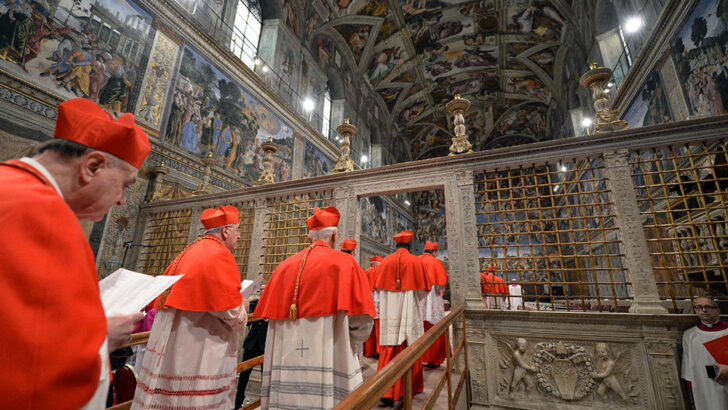Christiane Laudage (KNA)
The conclave begins on May 7. In the past, it was a race against time for the cardinals to get to Rome on time. One US cardinal was only successful on his third attempt.
The cardinals have already arrived in Rome and many of them attended the funeral of Pope Francis. Today, thanks to modern means of transport, it is no longer a problem to arrive within 24 to 36 hours. It used to be different. Technological progress over the past 150 years has played a decisive role in enabling more and more cardinals to arrive in Rome in time to exercise their right to vote.
Before there were telegrams, telephones and nowadays emails and text messages, it could take weeks for the news of a pope’s death to be announced. Historian Gabriele Annas has an example from the Middle Ages: the death of Pope Nicholas V on March 24, 1455 only became known on the morning of April 12, 1455 at the Imperial Diet in Wiener Neustadt. By then, on April 8, Alonso de Borja had already been elected as the new pope in Rome; the name: Calixt III. According to Annas, this news also only arrived three weeks later.
Technical innovations, better infrastructure
Almost exactly 150 years ago, in March 1875, Pius IX appointed New York Archbishop John McCloskey (1810-1885) as the first cardinal from a non-European country. It was the first step towards the internationalisation of the College of Cardinals, which Pope Francis has recently demonstratively extended to the very edges of the Earth.
At the 1878 conclave following the death of Pius IX, the situation for the cardinals was already much better. Information could be transmitted by telegram in the shortest possible time, no longer by post or messenger. It was also now possible to travel by train or steamship instead of by stagecoach. This was not only much more convenient, but also much faster.
Nevertheless, it was not always fast enough. Cardinals from the USA or Latin America in particular had to learn this painfully. Cardinal McCloskey arrived in Rome in 1878 five days after the start of the conclave. However, the cardinals had already elected Leo XIII three days earlier.
It went badly
Cardinal James Gibbons (1834-1921), Archbishop of Baltimore, was much luckier. He was in Rome when Leo XIII died in July 1903. He was therefore the first non-European and first US-American to take part in the conclave. In 1914, Joaquim Arcoverde de Albuquerque Cavalcanti (1850-1934), Archbishop of Rio de Janeiro, was the first cardinal from Latin America to take part in a papal election, from which Benedict XV emerged.
The two US cardinals at the time and the one from Canada arrived too late. They lost the race against time in both 1914 and 1922. A very bad thing: When Boston’s Cardinal William Henry O’Connell arrived in Rome in 1922, the bells were ringing. Pius XI had just been elected.
After being late twice, he asked the Pope to extend the deadline for the conclave in future. In 1939, he was actually there – because the cardinals were now allowed 15 days to reach the conclave on time. In the harbour at the time, the cardinals were urgently reminded of the dramatic world situation, as the German ship “Wilhelm Gustloff” was already moored there with a large swastika flag flying.
It’s quicker by aeroplane
Manuel Goncalves Cerejeira from Lisbon, the youngest voter at the time, caused quite a stir at the very short conclave in 1939. He travelled there by plane – the first cardinal ever to do so. Even in 1958, the oldest cardinal at the time was no longer afraid of flying. His colleagues had already cancelled his participation in the conclave, but the 92-year-old Archbishop of Santiago de Chile, Jose Maria Caro Rodriguez, insisted on attending and boarded the plane to Rome.
The plane made it easier for the cardinals. However, depending on where they lived, the journey was still a long one. The news agency UPI reported on a mishap that Cardinal Pio Taofinuu from Samoa experienced in the summer of 1978. He was travelling in a canoe on a pastoral visit when the boat tipped over; he fell into the sea and cut his foot on a coral. When he returned, he heard about the death of Pope Paul VI. He had to travel from Samoa to New Zealand to catch a plane to Rome. On the way, his foot became infected and he even had to have an operation before the conclave. At least he was on time.
Detroit’s Cardinal Edward Aloysius Mooney was also punctual in 1958. He lay down just before the conclave began. He died of a heart attack in his sleep – three hours before the papal election began.



